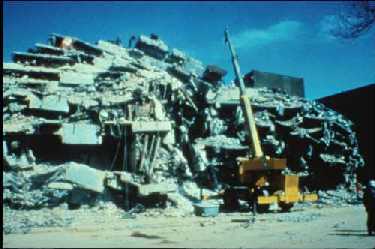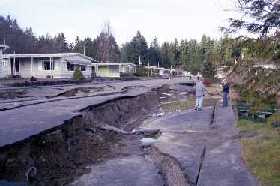

KGS Home > Geologic Hazards
Earthquake Effects
 How earthquakes affect humans, buildings, and bridges depends on many factors. The most important factors are earthquake magnitude, the distance from the earthquake center (called the epicenter), and the geologic conditions at a site.
How earthquakes affect humans, buildings, and bridges depends on many factors. The most important factors are earthquake magnitude, the distance from the earthquake center (called the epicenter), and the geologic conditions at a site.
Most damage during an earthquake is caused by ground motion. This photo shows the total collapse of the Juarez Hospital in Mexico City, caused by strong ground motion during the earthquake of September 19, 1985. The larger an earthquake's magnitude, the stronger the ground motion it generates. The level of ground motion at a site depends on its distance from the epicenter -- the closer a site is to the epicenter, the stronger the ground motion, and vice versa. Ground motion from a major earthquake in the New Madrid Seismic Zone is expected to be much stronger in western Kentucky than in the central and eastern parts of the state.
 The local geology and soil also play very important roles in earthquake damage. Soft soils overlying hard bedrock tend to amplify the ground motions -- this is known as ground-motion amplification. Amplified ground motion can cause excess damage, even to sites very far from the epicenter. Ground-motion amplification contributed to the heavy damages in Mexico City during the 1985 Mexico earthquake and in the Marina district of San Francisco during the 1989 Loma Prieta earthquake; both areas were more than 100 km away from the epicenters. Most of the damage in Maysville during the Sharpsburg earthquake of July 27, 1980, was caused by ground-motion amplification.
The local geology and soil also play very important roles in earthquake damage. Soft soils overlying hard bedrock tend to amplify the ground motions -- this is known as ground-motion amplification. Amplified ground motion can cause excess damage, even to sites very far from the epicenter. Ground-motion amplification contributed to the heavy damages in Mexico City during the 1985 Mexico earthquake and in the Marina district of San Francisco during the 1989 Loma Prieta earthquake; both areas were more than 100 km away from the epicenters. Most of the damage in Maysville during the Sharpsburg earthquake of July 27, 1980, was caused by ground-motion amplification.
 Soft sandy soils can be liquefied by strong ground motion -- a process called liquefaction. Liquefaction can result in foundation failure. The photo at left shows that sandy soil was liquefied and behaved like fluid during the Nisqually, Washington, earthquake of February 28, 2001.
Soft sandy soils can be liquefied by strong ground motion -- a process called liquefaction. Liquefaction can result in foundation failure. The photo at left shows that sandy soil was liquefied and behaved like fluid during the Nisqually, Washington, earthquake of February 28, 2001.
Many communities in Kentucky are set on soft soils, especially those along the Ohio and Mississippi River Valleys. Those communities are prone to ground-motion amplification and liquefaction hazards. The strong ground motion can also trigger landslides -- known as earthquake-induced landslides -- in areas with steep slope, such as eastern Kentucky. This slope failure was caused by the Nisqually, Washington, earthquake of February 28, 2001.